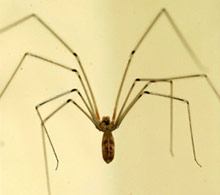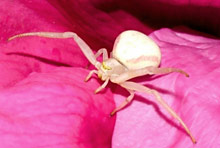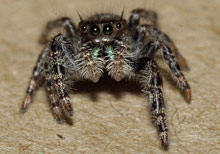Spiders
How to deal with spiders
 |
|
Cellar spider. Photo by Gary Alpert, Env. Health & Safety, Harvard U. |
 |
|
Crab spider. Photo by Cheryl Moorehead, Bugwood.org. |
 |
|
Jumping spider. Photo by Gary Alpert, Env. Health & Safety, Harvard U. |
If you don't want spiders in your space, you're not alone. Many people opt out of the pest control service that spiders provide. If you don't want them around, vacuuming them up will do the trick. While you're at it, figure out how to eliminate whatever insects it was feeding on—that's how to get rid of spiders for good. In many cases, this will involve installing screens on your windows and re-directing lights that attract flying insects.
A trapped spider may bite in self-defense. To reduce the risk of rolling on top of a spider in bed (a common source of bites), make your bed an island—minimize the number of ways a spider can climb onto your bed. Remove the dust ruffle and pull your bed away from any wall or nearby furniture.
What they look like
Two body parts and eight legs are giveaway traits that you've got spiders, not insects. Then take a look at their webs. Some make stylish Charlotte's Web-like creations; others make tunnel-like webs in the grass—pretty in the morning dew. Others make no webs at all. Some jump, some hang out, and some stay, hermit-like, in their trapdoor covered caverns. With so many kinds and no real threat, spiders make a wonderful subject for nature walks with kids. What's cooler than watching a spider eat a fly?
Where they live
They'll live where they're likely to catch their food—usually insects. You'll see them near windows, lights, and ceilings; they like basements, too. Outside, they're everywhere. Each kind has its own niche in nature, whether a yellow flower, mulch, or a tree.
What they do
The stress people feel about spiders is usually much worse than the effects of their venom. Most bites (even from brown recluse) go unnoticed and heal on their own. Poisonous widows and recluses cause concern in some southern states. The medical importance of yellow sac spiders and hobo spiders is in question. Tarantulas have "urticating" or stinging hairs that can be a source of irritation.
Resources
See results from the Northeastern IPM Center's resources database.
